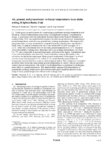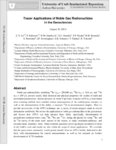1 - 25 of 18
| Creator | Title | Description | Subject | Date | ||
|---|---|---|---|---|---|---|
| 1 |
 |
Chapman, David S.; Harris, Robert N. | Mid-Latitude (30°-60° N) climatic warming inferred by combining borehole temperatures with surface air temperatures | We construct a mid-latitude (30°-60° N) reduced temperature-depth profile from a global borehole temperature database compiled for climate reconstruction. This reduced temperature profile is interpreted in terms of past surface ground temperature change and indicates warming on the order of 1°C... | Surface air temperature; Surface ground temperature; Borehole temperatures; Geothermal observations | 2001 |
| 2 |
 |
Chapman, David S. | Geothermics and climate change: 1. Analysis of borehole temperatures with emphasis on resolving power | Temperature-depth data from six boreholes in western Utah and nine boreholes in southeastern Utah are reanalyzed for evidence of ground surface temperature (GST) histories. We invert the temperature-depth data using the functional space inverse algorithm of Shen and Beck [1991, 1992] which we prefer... | Surface air temperature; Ground surface temperature; Borehole temperatures; Geothermal observations; Geothermics | 1998 |
| 3 |
 |
Chapman, David S. | Global warming - just hot air? | We know from weather station records that Earth's surface temperature has increased on average by 0.6 degrees C in the last 100 years. The 1990s have been the warmest decade on record. Over the same period, global sea level has increased by 10-20 cm. We know also that planet Earth has an atmosphere ... | Greenhouse Effect; Climate change | 1998 |
| 4 |
 |
Chapman, David S.; Harris, Robert N. | Climate change in India inferred from geothermal observations | Temporal variations in surface ground temperature impart a signal to the subsurface thermal regime that is captured in borehole temperature-depth profiles. Seventy temperature-depth profiles in India, located between 12o and 28oN, are analyzed to infer past changes in ground temperature. | Climate change; Borehole temperatures; Surface ground temperature; Surface air temperature; Geothermal observations; India | 2002 |
| 5 |
 |
Chapman, David S. | Reply to comment by T.J. Osborn and K. R. Briffa on "Mid-Latitude (30?-60?N) climatic warming inferred by combining borehole temperatures with surface air temperatures" | We thank Osborn and Briffa [2002] for their comment regarding our use of the climatic reconstruction of Overpeck et al. [1997]. We [Harris and Chapman, 2001] had taken a proxy, Arctic wide summer-weighted annual temperature reconstruction [Overpeck et al., 1997], given in dimensionless sigma units (... | Surface air temperature; Ground surface temperature; Borehole temperatures; Geothermal observations; Heat transfer | 2002 |
| 6 |
 |
Chapman, David S. | Geothermics and climate change: 2. Joint analysis of borehole temperature and meteorological data | Long-period ground surface temperature variations contained in bore hole temperature-depth profiles form a complementary climate change record to high-frequency, but noisy surface air temperature (SAT) records at weather stations. We illustrate the benefits of jointly analyzing geothermal and meteo... | Surface air temperature; Ground surface temperature; Borehole temperatures; Geothermal observations; Heat transfer | 1998 |
| 7 |
 |
Chapman, David S. | Borehole temperatures and climate change: ground temperature change in south India over the past two centuries | Variations in surface g round temperature (SGT) at the Earth's surface diffuse downward in a predictable way causing systematic perturbations to the subsurface temperature field. The pioneering study of Lachenbruch and Marsh all [1986] in Alaska demonstrated that present-day borehole temperature-dep... | 2012-01-01 | |
| 8 |
 |
Chapman, David S.; Harris, Robert N. | Snow and the ground temperature record of climate change | Borehole temperature-depth profiles contain a record of surface ground temperature (SGT) changes with time and complement surface air temperature (SAT) analysis to infer climate change over multiple centuries. Ground temperatures are generally warmer than air temperatures due to solar radiation effe... | Snow cover; Snow modeling; land/atmosphere interactions; Borehole climate reconstructions; Surface air temperature; Ground surface temperature; Borehole temperatures; Geothermal observations; Heat transfer | 2002 |
| 9 |
 |
Chapman, David S.; Harris, Robert N. | Stop-go temperature logging for precision applications | We describe a new field procedure for stop-go temperature logging of boreholes that attains millikelvin precision. Temperature is recorded continuously throughout the entire log, but the logging probe is held stationary for a fixed time at discrete depth intervals. Equilibrium temperatures at the di... | Temperature logging; Boreholes; Stop-go logging method | 2007 |
| 10 |
 |
Jarrard, Richard D. | Milankovitch paleoceanographic cycles in geophysical logs from ODP Leg 105, Labrador Sea and Baffin Bay | Ocean Drilling Program (ODP) Sites 645 and 646, in Baffin Bay and the Labrador Sea, respectively, were logged following drilling during Leg 105. Geophysical logs in ODP drill sites yield long, continuous records of sedimentary sequences and thus provide the opportunity for examining evidence of peri... | 1990 | |
| 11 |
 |
Brown, Francis Harold | The evolution of neogene terrestrial ecosystems in Europe | The Pliocene-Pleistocene chronology of hominid and other vertebrate evolution in East Africa is largely constrained by isotopic dating and regional intercorrelation of volcanic ash layers. Some eruptions were of sufficient magnitude or duration that their widespread tephra dispersal defines a serie... | 1999 | |
| 12 |
 |
Jewell, Paul | Controls of tufa development in Pleistocene Lake Bonneville, Utah | Prominent tufa localities along the Provo level (∼14,000 14C yr B.P.) shoreline in Pleistocene Lake Bonneville have been characterized in detail. Three types of tufa are recognized: capping tufa, beachrock, and capping tufa over beachrock. Capping tufa and beachrock are end members of a continuum ... | Tufa; Pleistocene; Pluvial lakes | 2006 |
| 13 |
 |
Chapman, David S. | Air, ground, and groundwater recharge temperatures in an alpine setting, Brighton Basin, Utah | Noble gases are useful tracers for constraining groundwater recharge temperature and elevation, critical in determining source areas of groundwater recharge in mountainous terrain. A monitoring network in the alpine Brighton Basin in the Wasatch Mountains of northern Utah, USA, was established to ex... | 2012-01-01 | |
| 14 |
 |
Solomon, Douglas Kip | Tracer applications of noble gas radionuclides in the geosciences | Noble gas radionuclides, including 81Kr (t1/2 = 229,000 yr), 85Kr (t1/2 = 10.8 yr), and 39Ar (t1/2 = 269 yr), possess nearly ideal chemical and physical properties for studies of earth and environmental processes. Recent advances in Atom Trap Trace Analysis (ATTA), a laser-based atom counting method... | 2014-01-01 | |
| 15 |
 |
Jewell, Paul | Circulation, salinity, and dissolved oxygen in the Cretaceous North American seaway | Critical paleoceanographic problems regarding the maximum transgressive phase of the Cretaceous North American seaway have been studied with a three-dimensional ocean circulation model. Four simulations employing minimum and maximum solar insolation winds from the Cretaceous and a wide range of pre... | Cretaceous North American Seaway | 1996 |
| 16 |
 |
Brown, Francis Harold | Geological development of the Omo-Turkana Basin during the pliocene and pleistocene epochs | Pliocene and Pleistocene deposits of the Omo-Turkana Basin extend from 6?N latitude to about 2?N latitude (-450 km), and laterally from about 35.5?E to 36.5?E. Sediments are brought to the basin by the Omo River which rises in Ethiopia, and by the Turkwel and Kerio Rivers which rise in Kenya and Uga... | 2004 | |
| 17 |
 |
Chapman, David S. | Thermal analysis of the southern Powder River Basin, Wyoming | Temperature and geologic data from over 3000 oil and gas wells within a 180 km x 30 km area that transect across the southern Powder River Basin in Wyoming, U.S.A., were used to determine the present thermal regime of the basin. Three-dimensional temperature fields within the transect, based on... | Thermal analysis; Inversion; Bottom hole temperature | 1996-11 |
| 18 |
 |
Brown, Francis Harold | Pliocene/pleistocene formations in the lower omo basin, southern Ethiopia | Following a two month geological reconnaissance by one of us (FHB) in 1966, four seasons of fieldwork by members of the Omo Research Expedition has added greatly to our previous, scanty knowledge of the late Cenozoic history of the lower Omo basin in southern Ethiopia. Eduard Suess (in: von Hohnel ... | 1970 |
1 - 25 of 18
